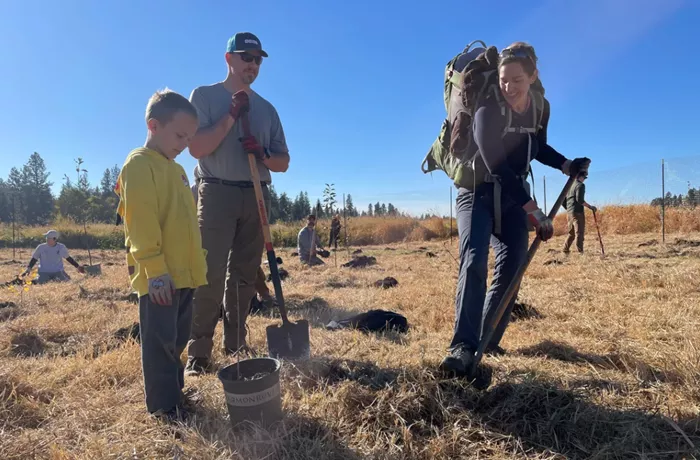With her 9-month-old son strapped to her back, Kirsten Frost Andersen pushed her shovel through the thick reed canary grass into the dark, moist soil. Her 7-year-old son, Aidan Andersen, helped her plant a native tree in the small hole she dug.
The family was among 200 volunteers participating in Reforest Spokane Day at the James T. Slavin Conservation Area, located about 20 minutes south of downtown Spokane. Alongside her husband, Craig Andersen, and their children, the family contributed to planting 1,100 native trees, which will bring beauty, shade, and ecological benefits to the area for years to come.
“It’s important to involve kids in events like this so they learn the value of protecting nature and taking care of the environment,” Craig Andersen said.
Reforest Spokane Day has been organized by The Lands Council since 2012, selecting areas in need of forest revitalization. This year’s tree-planting event, held on a sunny Saturday, was a collaborative effort between The Lands Council, Inland Northwest Land Conservancy, Spokane County, U.S. Fish and Wildlife Service, and Natural Resources Conservation Service.
Amanda Parrish, Executive Director of The Lands Council, explained that the trees planted near a wetland at Slavin Conservation Area will serve multiple purposes once they mature. These include filtering fertilizer runoff from nearby agricultural fields before it reaches the wetland, providing shade to cool the water, and increasing dissolved oxygen levels essential for fish.
“These trees are part of creating a healthier habitat for wildlife,” said Dave Schaub, Executive Director of Inland Northwest Land Conservancy. “As we face climate change and increasing development, it’s crucial for all of us to work together to protect places like this.”
Kat Hall, The Lands Council’s Restoration Program Director, demonstrated to the volunteers how to plant various trees and shrubs, including mountain alder, red osier dogwood, black cottonwood, quaking aspen, golden currant, and black hawthorn.
“It’s uplifting to see this community come together year after year to improve our ecosystems,” Hall said.
Brian Walker, a private lands biologist with the U.S. Fish and Wildlife Service, noted that the agency provided the trees from its nursery at Turnbull National Wildlife Refuge. He emphasized that, over time, these plants will form a canopy that shades out the invasive reed canary grass volunteers were digging through.
Hall added that the goal is to restore the area to a “more pristine state,” with the trees expected to fully mature over the next 20 years, depending on the species.
The volunteers planted trees in three areas protected by netted fencing to prevent animals like deer, moose, and elk from eating the young plants. Spokane County natural resource specialist Dan Maus said the fencing would be removed once the trees are established and can withstand wildlife browsing.
Craig Andersen, a landscape architect, said he’s been involved with The Lands Council for years and has participated in many Reforest Spokane Days with his family.
His son, Aidan, was particularly enthusiastic about finding worms while planting trees. Craig Andersen noted that these activities not only teach his son to care for the environment but also allow him to enjoy the outdoors.
“I definitely prefer being outside more than inside,” Aidan said.
For Kirsten Frost Andersen, who carried her baby, Reid Andersen, on her back, the day was also a social event. She said she and her husband often run into colleagues from work during these tree-planting efforts.
“It’s great to see all this positive energy,” she said. “So many people are helping to preserve our area around Spokane.”
Hall noted that the October planting day always draws a strong turnout.
“There’s such a good energy when people come together, plant trees, and enjoy being outside with each other,” Hall said.
Related topics:
- How Cities Are Integrating Native Plants into Landscaping?
- Plants have a hidden tool to cope with stress.
- our New Thai Plant Species Discovered, Including One That Resembles a Monkey’s Face


